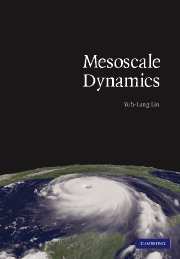Book contents
- Frontmatter
- Contents
- Preface
- 1 Overview
- 2 Governing equations for mesoscale motions
- 3 Basic wave dynamics
- 4 Mesoscale wave generation and maintenance
- 5 Orographically forced flows
- 6 Thermally forced flows
- 7 Mesoscale instabilities
- 8 Isolated convective storms
- 9 Mesoscale convective systems
- 10 Dynamics of fronts and jet streaks
- 11 Dynamics of orographic precipitation
- 12 Basic numerical methods
- 13 Numerical modeling of geophysical fluid systems
- 14 Parameterizations of physical processes
- Appendices
- Index
- References
13 - Numerical modeling of geophysical fluid systems
Published online by Cambridge University Press: 15 December 2009
- Frontmatter
- Contents
- Preface
- 1 Overview
- 2 Governing equations for mesoscale motions
- 3 Basic wave dynamics
- 4 Mesoscale wave generation and maintenance
- 5 Orographically forced flows
- 6 Thermally forced flows
- 7 Mesoscale instabilities
- 8 Isolated convective storms
- 9 Mesoscale convective systems
- 10 Dynamics of fronts and jet streaks
- 11 Dynamics of orographic precipitation
- 12 Basic numerical methods
- 13 Numerical modeling of geophysical fluid systems
- 14 Parameterizations of physical processes
- Appendices
- Index
- References
Summary
In Chapter 12, we discussed various numerical approximations of the advection equation. However, to simulate a geophysical fluid system, such as the atmosphere and ocean, within a finite region, we need to choose the domain size, grid size, time interval, total integration time, and consider other factors, such as the initial condition and boundary conditions. In addition, when we deal with a real fluid system, the governing equations are much more complicated than the one-dimensional, linear advection equation, as considered in Chapter 12. For example, we have to integrate three-dimensional nonlinear governing equations with several dependent variables, instead of a one-dimensional advection equation with only one variable. When a nonlinear equation is being approximated by numerical methods, one may face new problems, such as nonlinear computational instability and nonlinear aliasing. Special numerical techniques are required to avoid these types of problems. Once optimal approximate forms of the equations are selected, it is still necessary to define the domain and grid structure over which the partial differential equations will be approximated. In this chapter, we will also briefly describe on how to build a basic numerical model based on a set of partial differential equations governing a shallow water system, and a hydrostatic or nonhydrostatic continuously stratified fluid system.
Grid systems and vertical coordinates
The first step in developing a mesoscale numerical model is to determine the appropriate domain size, grid intervals, time interval, and total integration time of the model.
- Type
- Chapter
- Information
- Mesoscale Dynamics , pp. 518 - 562Publisher: Cambridge University PressPrint publication year: 2007



